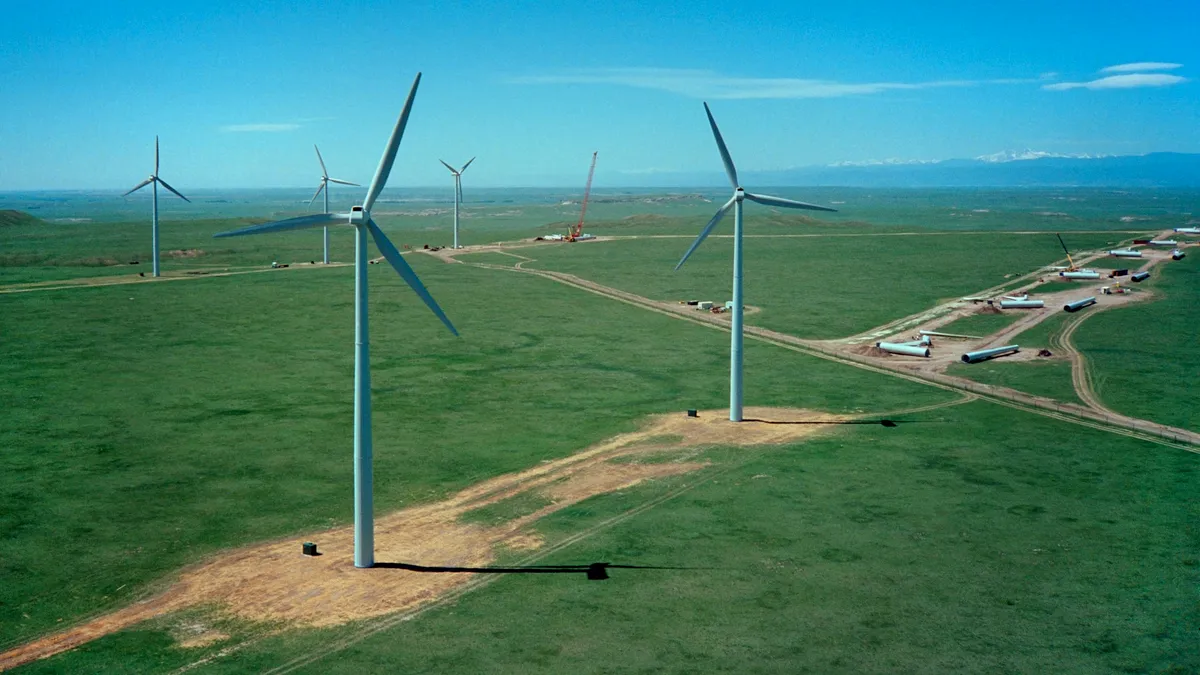Dive Brief:
- Under a least-cost approach to meeting growing electric demand in Colorado, fossil-fueled generation would meet about 1% of the state’s electricity use in 2040, according to a draft study prepared for the Colorado Energy Office.
- More than three-quarters of electricity comes from in-state wind and solar in 2040 in the least-cost scenario; 16% comes from out-of-state imports of near zero-emissions electricity; and 10% from energy efficiency, with the rest coming from other sources, Ascend Analytics, a consulting firm, said in its draft study released this month. The scenario retains 8,215 MW of gas-fired generation to meet capacity needs.
- The study will be used as part of the debate in Colorado’s next legislative session on expanding the state’s clean energy goals beyond an 80% greenhouse gas emissions reduction target for 2030, Keith Hay, senior director of policy for the Energy Office, said Monday. The session begins in January.
Dive Insight:
In a surprise, Ascend Analytics found that a technology-neutral, least cost approach — expected to cost $37.5 billion on a net present value basis — would slash carbon emissions from the state’s power sector 98.5% below 2005 levels by 2040, according to Hay.
The Energy Office didn’t expect the “business as usual” scenario would come so close to eliminating carbon emissions from the power sector, he said.
The study modeled five additional scenarios that reach zero carbon emissions from power plants by 2040. The least expensive of those scenarios would be 25% more expensive than the business as usual scenario with its 98.5% reduction. At about $56 billion, a scenario that included only wind, solar and battery storage was the most expensive path to cutting all carbon emissions from the power sector, according to the analysis.
The model does not select gas with carbon capture or advanced nuclear modular reactors in any scenario because of their cost, Ascend said.
The draft modeling projects that by 2040, Colorado’s peak electrical demand will grow 40% from this year to 14,791 MW, driven by economic and population growth as well as shifts to electric vehicles, building electrification, and electrification of oil and gas end uses, Ascend said.
Under the business as usual scenario, the state’s installed generating capacity grows to 44,474 MW by 2040, up from about 18,100 MW last year. In contrast, the state’s capacity under the zero emissions, wind, solar and battery storage scenario grows to almost 75,000 MW, according to the draft study.
The study was developed with input from stakeholders, including utilities and environmental justice groups, according to Hay. The Energy Office is getting feedback on the draft study and expects to release a final report next month, he said.
Under Colorado’s laws, Public Service Co. of Colorado, an Xcel Energy utility, Black Hills Energy and Tri-State Generation and Transmission must file integrated resource plans for review by the Colorado Public Utilities Commission. Municipal and cooperative utilities develop resource plans approved by their boards. All the plans are reviewed by the Colorado Department of Public Health and Environment to make sure they meet the state’s carbon emissions reduction requirements.
The results of the business as usual scenario indicate Colorado’s resource planning process has worked well, according to Hay.
“The framework that we have put in place that focuses on emissions reductions, on working within a utility electric resource planning process, really has driven results,” Hay said. “We have been able to do all of this at … a reasonable cost and rate impact across the state generally.”
Colorado’s utility-scale renewable capacity grew to 7,746 MW this year, up from 3,129 MW a decade ago, according to the U.S. Energy Information Administration. In the same period, the state’s fossil-fueled capacity dipped to 10,499 MW from 11,074 MW.














